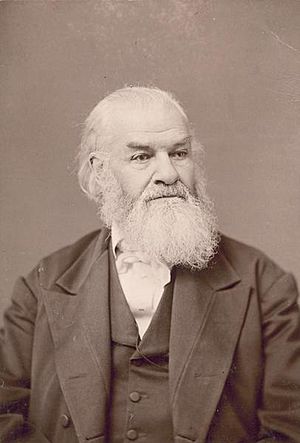Warren Chase facts for kids
Quick facts for kids
Warren Chase
|
|
|---|---|
 |
|
| Member of the Wisconsin Senate from the 4th district |
|
| In office June 5, 1848 – January 9, 1850 |
|
| Preceded by | Position Established |
| Succeeded by | John A. Eastman |
| Member of the California State Senate | |
| In office January 1880 – January 1883 |
|
| Personal details | |
| Born | January 5, 1813 Pittsfield, New Hampshire |
| Died | February 25, 1891 (aged 78) Cobden, Illinois |
| Resting place | Cobden Cemetery Cobden, Illinois |
| Political party | Greenback (1882) Workingmen (1879) Free Soil (1849) Democratic (1848) |
| Spouses |
|
| Children |
|
| Parents |
|
| Profession | farmer, politician |
Warren Chase (January 5, 1813 – February 25, 1891) was an important American pioneer, reformer, and politician. He served in the state senates of both Wisconsin and California. He even ran for Governor of Wisconsin in 1849.
Warren Chase's Early Life
Warren Chase was born in Pittsfield, New Hampshire, on January 5, 1813. His mother, Susanna Durgin, faced challenges raising him because she was unmarried. Warren's father, Simon Chase, fought in the War of 1812 and died when Warren was less than two years old. Sadly, his mother also passed away a few years later, when Warren was just five.
As a young child, Warren lived briefly with a Quaker family. After his mother's death, he was placed in the care of David Fogg and his family. Warren later described this time as very difficult. He felt he was treated like a servant and did not get to go to school. At age fourteen, he still could not read or write.
He eventually ran away to his grandmother's home in Pittsfield. With help from his grandmother and others, Warren was moved to live with his paternal grandfather, Nathaniel Chase. There, he finally received a proper education and a good upbringing. In 1834, he moved to Monroe, Michigan, and then in 1838, he settled in Kenosha, Wisconsin (which was called "Southport" back then).
Life and Work in Wisconsin
In 1843, Warren Chase became very interested in the ideas of a French philosopher named Charles Fourier. Fourier believed in "Associationism," which was about people living together in communities and sharing resources. Chase was very excited about this idea. He helped start meetings to create a local community based on these principles.
On March 23, 1844, a group of people who supported this idea met in Southport. They elected officers and chose Warren Chase as one of the leaders. They decided to raise money and buy land for their new community. They bought about 960 acres of land, which later became the town of Ceresco, Wisconsin. This town eventually merged into Ripon, Wisconsin.
Chase also played a part in founding Ripon College. He was a strong supporter of several important movements of his time:
- The temperance movement, which worked to reduce alcohol use.
- The abolitionist movement, which fought to end slavery.
- The spiritualist movement, which explored connections with spirits.
Warren Chase was involved in politics too. He served in two important meetings that helped create Wisconsin's constitution in 1846 and 1847. He was then elected to the first Wisconsin Senate from the 4th Senate district as a member of the Democratic Party. In 1849, he ran for Governor of Wisconsin as a candidate for the new Free Soil Party.
Moving West and Later Years
After the community in Wisconsin ended, Warren Chase moved to Michigan in 1853. Later, he moved to Missouri, where he was chosen as a Presidential elector in the 1872 election. This meant he helped cast votes for president.
In 1876, he moved to Santa Barbara, California, and worked as an editor for a newspaper called the Independent. While in California, he was elected to the California State Senate. He served in the California Senate from 1879 to 1882. He later ran for Congress in California.
Death
Warren Chase passed away in Cobden, Illinois, in 1891. He was buried at Cobden Cemetery.

